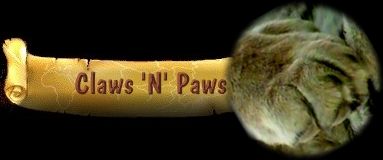
Claws, Paws & Pug Marks - Page 1&2: Claws| 3&4: Pug Marks | 5&6: Declawing

Claws, Paws & Pug Marks -
Page 1&2: Claws|
3&4: Pug Marks
| 5&6: Declawing
|
Above: An incomplete onychectomy has resulted in a draining sinus associated with the regrowth of a claw. This is a common clinical sign in the case of this complication. Above: Necrosis (decay) and sloughing off of soft tissue. Excessively tight bandaging was considered to be the cause. Above: Onychectomy was carried out on this cat at 2 years of age. The photograph was taken when the animal was 13-years-old. Multiple claw fragments were located in the damaged area. |
Complications from declawing:At best there are the usual risks associated with anaesthesia and extreme discomfort after the operation. Rates of serious complication for this procedure are considered relatively high when compared to other so-called routine operations:
Where infection sets in antibiotics will be required. Severe infections may need fluids and other more concentrated measures.
The affected digits may discharge and though antibiotics can control the problem it will usually reoccur unless another operation is carried out to remove the growing claw and tissue responsible. During
this operation surgical exploration is carried out -- and may
be repeated as required. An onychectomy with severe complications may result in multiple operations for the animal, each with its own discomforts and operative/post-operative risks. |
|
Claws, Paws & Pug Marks - Page 1&2: Claws| 3&4: Pug Marks | 5&6: Declawing Taxonomy
| Whiskers
| Hearing & Ear Spots | Eyesight
| Smell | Teeth
| Communication | Flehman
| Genetics | |
|
Photography
With Thanks To The Auckland
S.P.C.A. |